IT Manager Resume Examples
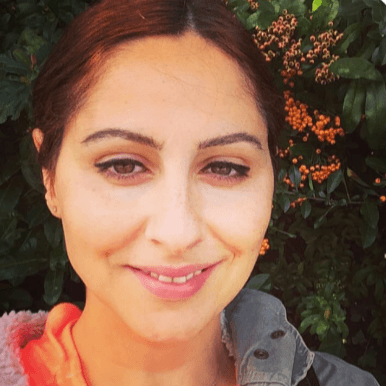
Jul 18, 2024
|
12 min read
Turbocharge your IT manager resume: Tips to connect your skills with top companies in the IT network.
Rated by 348 people

Network Operations Manager
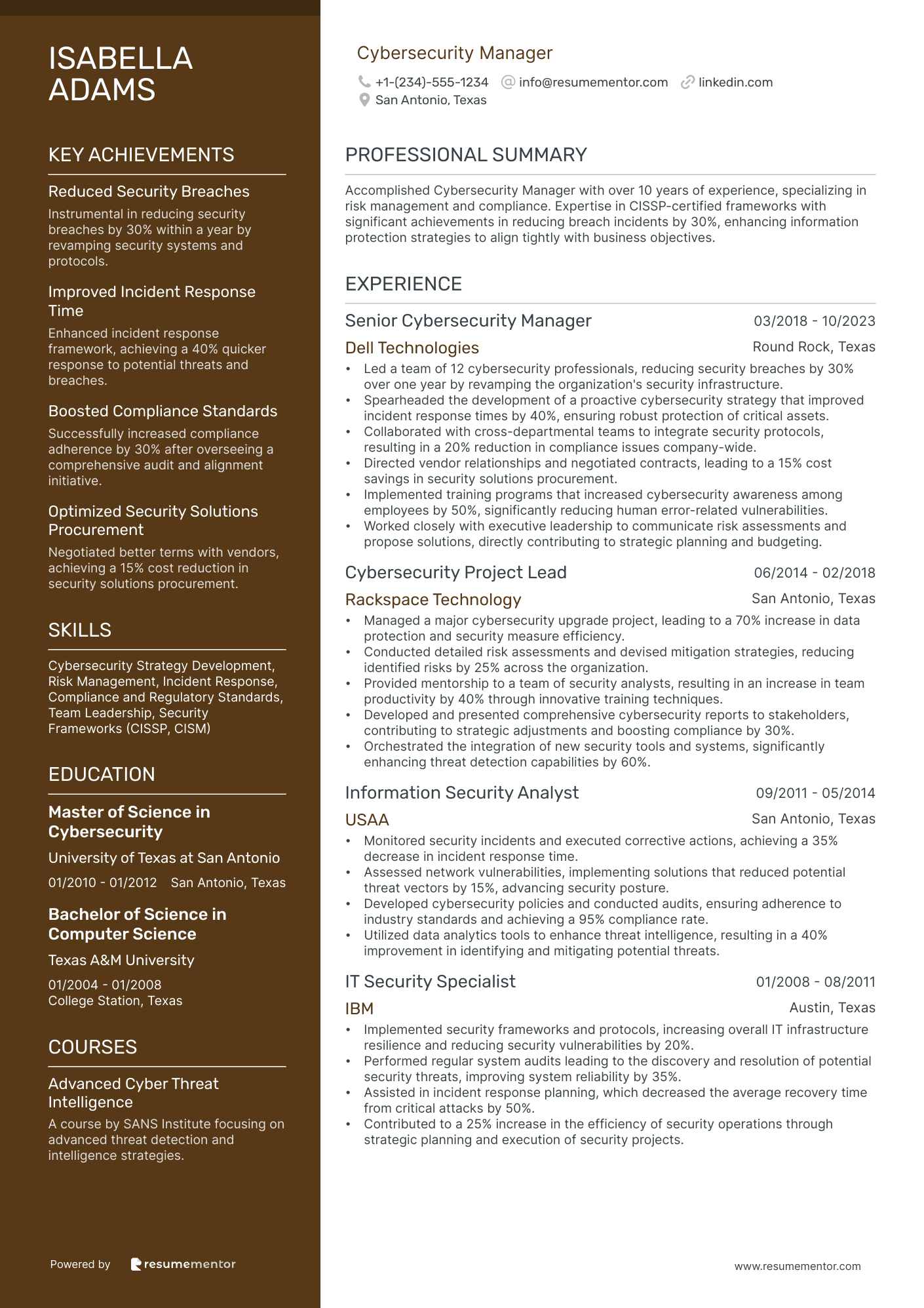
Cybersecurity Manager
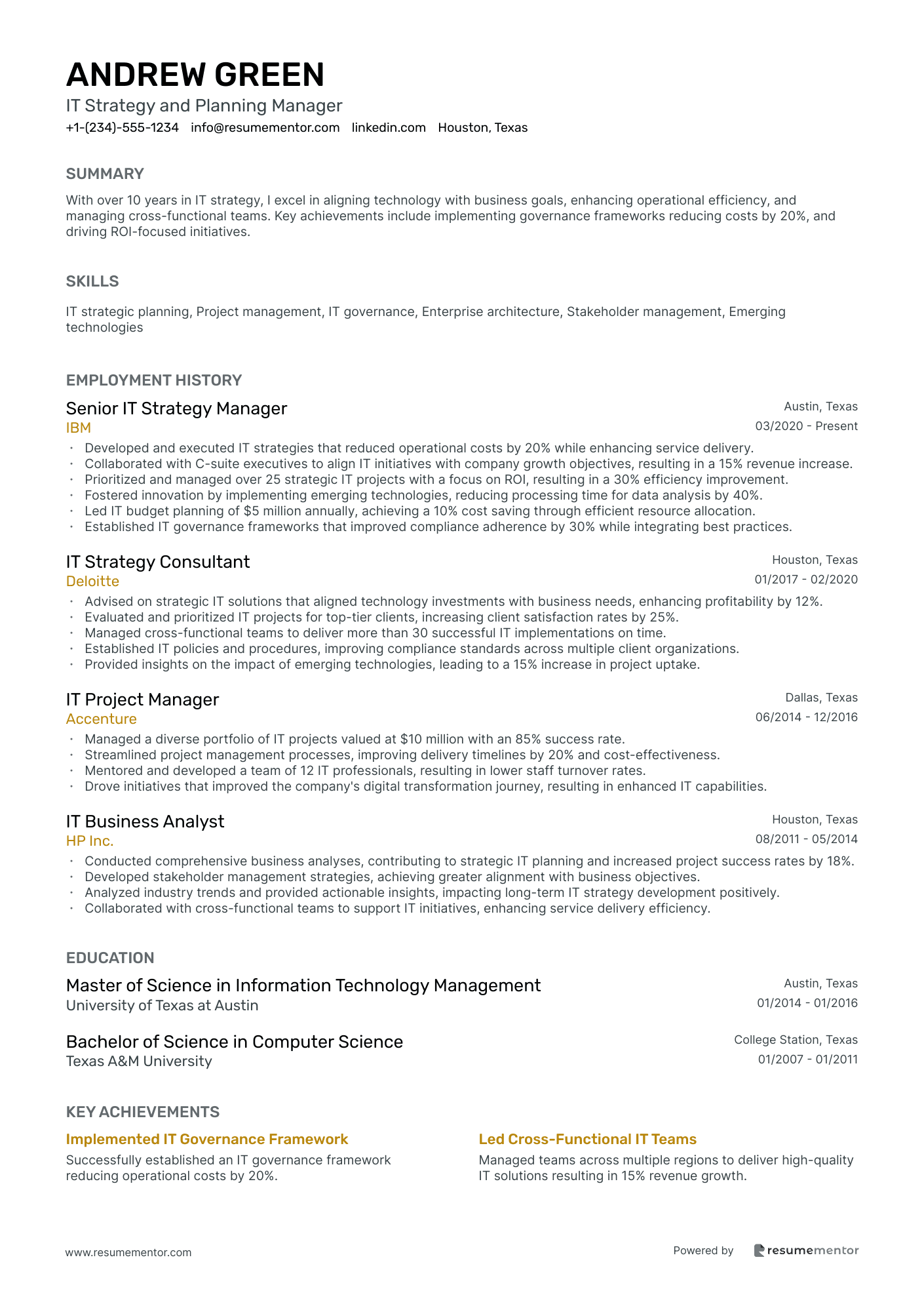
IT Strategy and Planning Manager
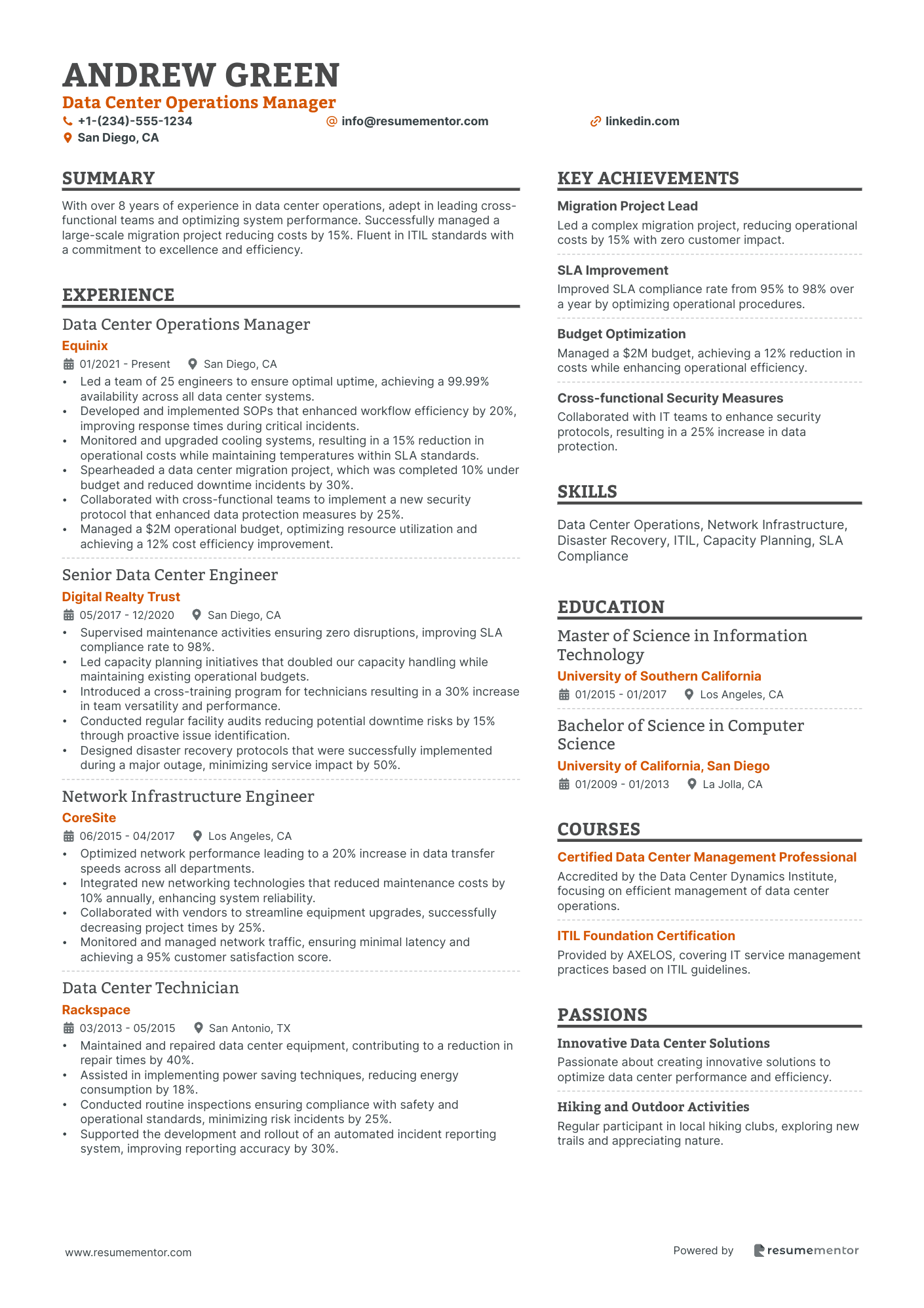
Data Center Operations Manager
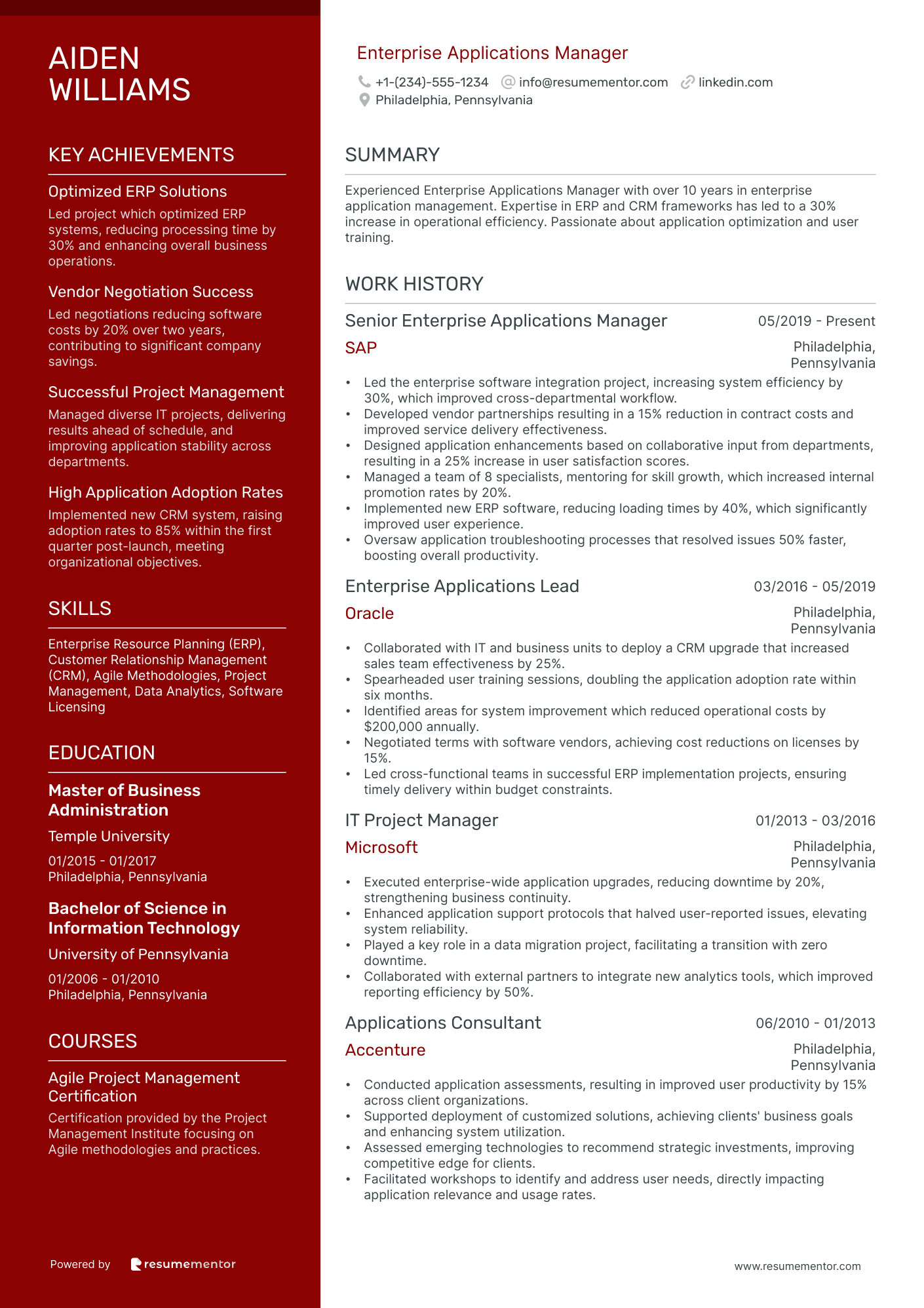
Enterprise Applications Manager
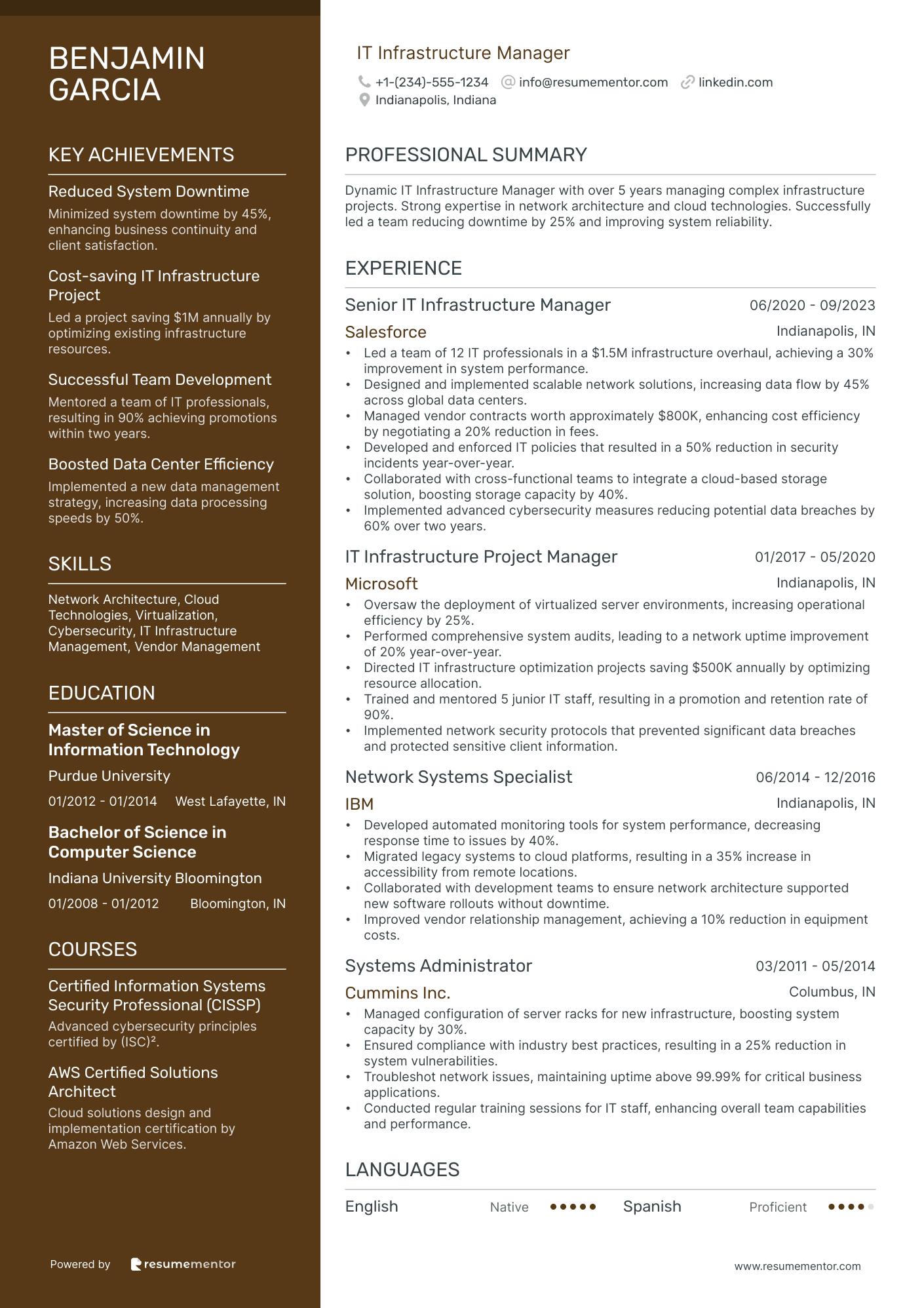
IT Infrastructure Manager
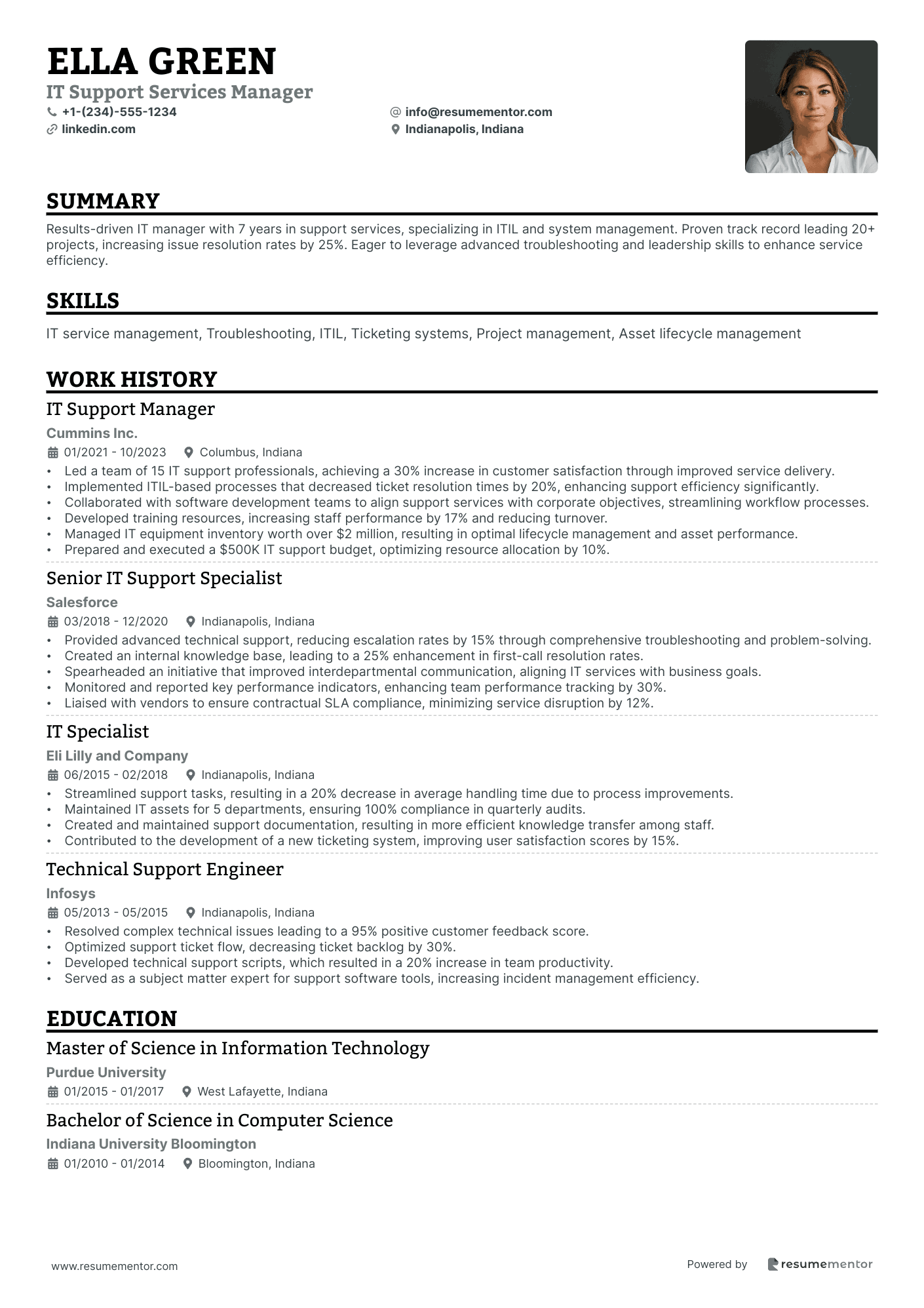
IT Support Services Manager
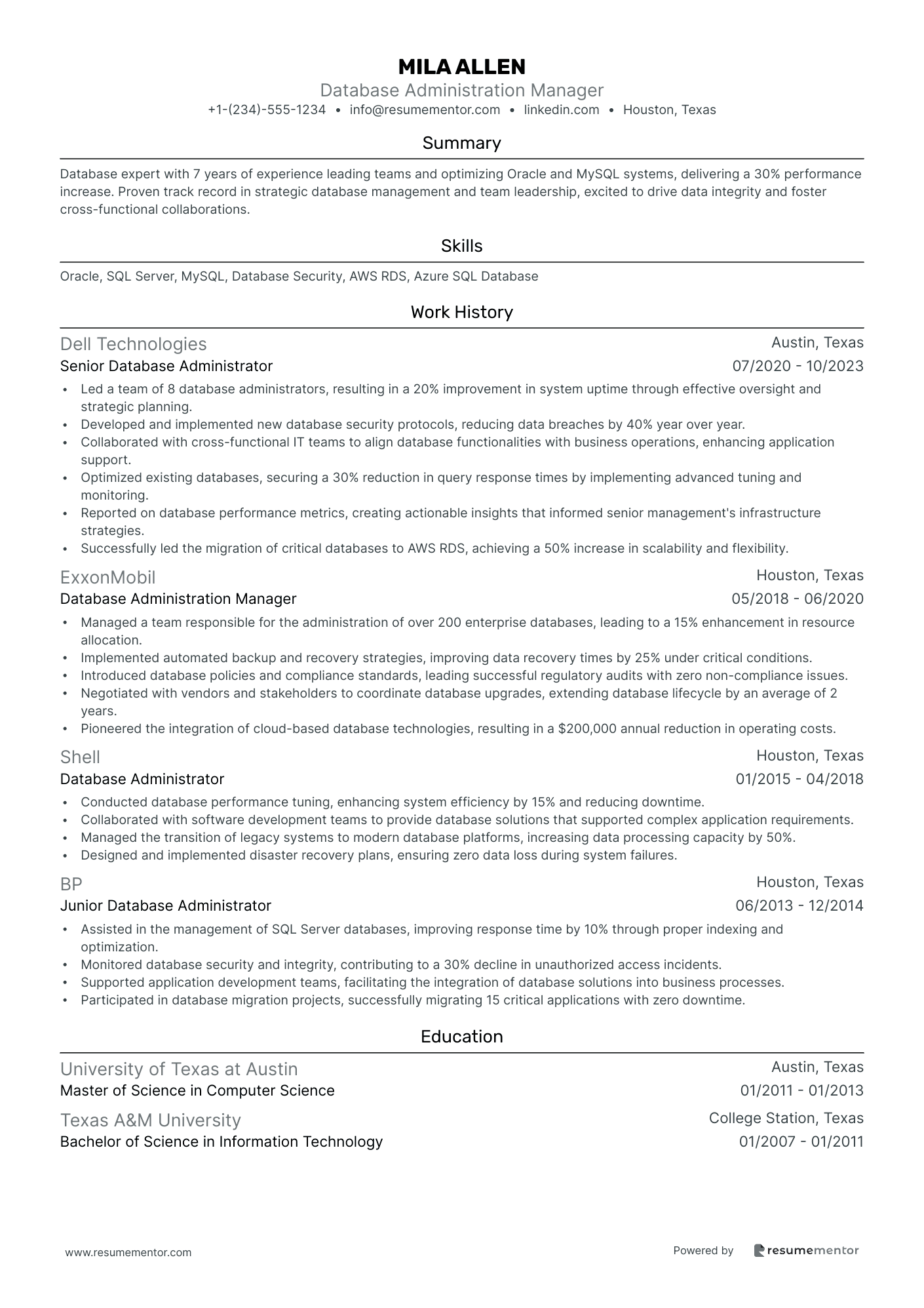
Database Administration Manager

Network Operations Manager resume sample
- •Managed a team of 12 network engineers in deploying network solutions, leading to a 30% improvement in overall network efficiency within the first year.
- •Developed and executed a disaster recovery plan, reducing potential downtime by 40% and increasing network reliability and uptime.
- •Optimized network performance by implementing advanced monitoring tools, resulting in a 25% reduction in troubleshooting time.
- •Collaborated with cross-functional teams to execute network upgrades, aligning network capabilities with strategic business goals and improving customer satisfaction by 15%.
- •Led evaluation and integration of new technologies, improving network security measures and reducing vulnerabilities by 60%.
- •Managed third-party vendor relationships and service level agreements, achieving a 10% cost reduction in operational expenses.
- •Directed the network operations team of 10, implementing strategies resulting in a 20% increase in network efficiency.
- •Improved disaster recovery protocols, ensuring near-zero data loss and faster service restoration in critical incidents.
- •Spearheaded network capacity planning projects, allowing a 15% growth in user base without compromising network performance.
- •Championed the use of network analytics, leading to a proactive maintenance approach and reducing outages by 50%.
- •Facilitated training programs and mentorships for engineers, improving staff retention and career advancement by 20%.
- •Led a team of 8 engineers, optimizing network configurations which increased data throughput by 45%.
- •Implemented a new network monitoring system, resulting in 35% faster resolution of network issues.
- •Conducted vendor assessments and selection, improving network hardware reliability by 25%.
- •Developed a network security audit process, reducing identified vulnerabilities by 50% across the organization.
- •Supported network infrastructure upgrades that resulted in a 30% increase in efficiency and reduced downtime.
- •Assisted in designing and implementing a secure network architecture that decreased unauthorized access attempts by 20%.
- •Monitored network performance metrics and provided detailed reports, aiding in a 15% faster troubleshooting process.
- •Collaborated with IT staff to implement a comprehensive network training program, boosting team knowledge by 40%.
Cybersecurity Manager resume sample
- •Led a team of 12 cybersecurity professionals, reducing security breaches by 30% over one year by revamping the organization's security infrastructure.
- •Spearheaded the development of a proactive cybersecurity strategy that improved incident response times by 40%, ensuring robust protection of critical assets.
- •Collaborated with cross-departmental teams to integrate security protocols, resulting in a 20% reduction in compliance issues company-wide.
- •Directed vendor relationships and negotiated contracts, leading to a 15% cost savings in security solutions procurement.
- •Implemented training programs that increased cybersecurity awareness among employees by 50%, significantly reducing human error-related vulnerabilities.
- •Worked closely with executive leadership to communicate risk assessments and propose solutions, directly contributing to strategic planning and budgeting.
- •Managed a major cybersecurity upgrade project, leading to a 70% increase in data protection and security measure efficiency.
- •Conducted detailed risk assessments and devised mitigation strategies, reducing identified risks by 25% across the organization.
- •Provided mentorship to a team of security analysts, resulting in an increase in team productivity by 40% through innovative training techniques.
- •Developed and presented comprehensive cybersecurity reports to stakeholders, contributing to strategic adjustments and boosting compliance by 30%.
- •Orchestrated the integration of new security tools and systems, significantly enhancing threat detection capabilities by 60%.
- •Monitored security incidents and executed corrective actions, achieving a 35% decrease in incident response time.
- •Assessed network vulnerabilities, implementing solutions that reduced potential threat vectors by 15%, advancing security posture.
- •Developed cybersecurity policies and conducted audits, ensuring adherence to industry standards and achieving a 95% compliance rate.
- •Utilized data analytics tools to enhance threat intelligence, resulting in a 40% improvement in identifying and mitigating potential threats.
- •Implemented security frameworks and protocols, increasing overall IT infrastructure resilience and reducing security vulnerabilities by 20%.
- •Performed regular system audits leading to the discovery and resolution of potential security threats, improving system reliability by 35%.
- •Assisted in incident response planning, which decreased the average recovery time from critical attacks by 50%.
- •Contributed to a 25% increase in the efficiency of security operations through strategic planning and execution of security projects.
IT Strategy and Planning Manager resume sample
- •Developed and executed IT strategies that reduced operational costs by 20% while enhancing service delivery.
- •Collaborated with C-suite executives to align IT initiatives with company growth objectives, resulting in a 15% revenue increase.
- •Prioritized and managed over 25 strategic IT projects with a focus on ROI, resulting in a 30% efficiency improvement.
- •Fostered innovation by implementing emerging technologies, reducing processing time for data analysis by 40%.
- •Led IT budget planning of $5 million annually, achieving a 10% cost saving through efficient resource allocation.
- •Established IT governance frameworks that improved compliance adherence by 30% while integrating best practices.
- •Advised on strategic IT solutions that aligned technology investments with business needs, enhancing profitability by 12%.
- •Evaluated and prioritized IT projects for top-tier clients, increasing client satisfaction rates by 25%.
- •Managed cross-functional teams to deliver more than 30 successful IT implementations on time.
- •Established IT policies and procedures, improving compliance standards across multiple client organizations.
- •Provided insights on the impact of emerging technologies, leading to a 15% increase in project uptake.
- •Managed a diverse portfolio of IT projects valued at $10 million with an 85% success rate.
- •Streamlined project management processes, improving delivery timelines by 20% and cost-effectiveness.
- •Mentored and developed a team of 12 IT professionals, resulting in lower staff turnover rates.
- •Drove initiatives that improved the company's digital transformation journey, resulting in enhanced IT capabilities.
- •Conducted comprehensive business analyses, contributing to strategic IT planning and increased project success rates by 18%.
- •Developed stakeholder management strategies, achieving greater alignment with business objectives.
- •Analyzed industry trends and provided actionable insights, impacting long-term IT strategy development positively.
- •Collaborated with cross-functional teams to support IT initiatives, enhancing service delivery efficiency.
Data Center Operations Manager resume sample
- •Led a team of 25 engineers to ensure optimal uptime, achieving a 99.99% availability across all data center systems.
- •Developed and implemented SOPs that enhanced workflow efficiency by 20%, improving response times during critical incidents.
- •Monitored and upgraded cooling systems, resulting in a 15% reduction in operational costs while maintaining temperatures within SLA standards.
- •Spearheaded a data center migration project, which was completed 10% under budget and reduced downtime incidents by 30%.
- •Collaborated with cross-functional teams to implement a new security protocol that enhanced data protection measures by 25%.
- •Managed a $2M operational budget, optimizing resource utilization and achieving a 12% cost efficiency improvement.
- •Supervised maintenance activities ensuring zero disruptions, improving SLA compliance rate to 98%.
- •Led capacity planning initiatives that doubled our capacity handling while maintaining existing operational budgets.
- •Introduced a cross-training program for technicians resulting in a 30% increase in team versatility and performance.
- •Conducted regular facility audits reducing potential downtime risks by 15% through proactive issue identification.
- •Designed disaster recovery protocols that were successfully implemented during a major outage, minimizing service impact by 50%.
- •Optimized network performance leading to a 20% increase in data transfer speeds across all departments.
- •Integrated new networking technologies that reduced maintenance costs by 10% annually, enhancing system reliability.
- •Collaborated with vendors to streamline equipment upgrades, successfully decreasing project times by 25%.
- •Monitored and managed network traffic, ensuring minimal latency and achieving a 95% customer satisfaction score.
- •Maintained and repaired data center equipment, contributing to a reduction in repair times by 40%.
- •Assisted in implementing power saving techniques, reducing energy consumption by 18%.
- •Conducted routine inspections ensuring compliance with safety and operational standards, minimizing risk incidents by 25%.
- •Supported the development and rollout of an automated incident reporting system, improving reporting accuracy by 30%.
Enterprise Applications Manager resume sample
- •Led the enterprise software integration project, increasing system efficiency by 30%, which improved cross-departmental workflow.
- •Developed vendor partnerships resulting in a 15% reduction in contract costs and improved service delivery effectiveness.
- •Designed application enhancements based on collaborative input from departments, resulting in a 25% increase in user satisfaction scores.
- •Managed a team of 8 specialists, mentoring for skill growth, which increased internal promotion rates by 20%.
- •Implemented new ERP software, reducing loading times by 40%, which significantly improved user experience.
- •Oversaw application troubleshooting processes that resolved issues 50% faster, boosting overall productivity.
- •Collaborated with IT and business units to deploy a CRM upgrade that increased sales team effectiveness by 25%.
- •Spearheaded user training sessions, doubling the application adoption rate within six months.
- •Identified areas for system improvement which reduced operational costs by $200,000 annually.
- •Negotiated terms with software vendors, achieving cost reductions on licenses by 15%.
- •Led cross-functional teams in successful ERP implementation projects, ensuring timely delivery within budget constraints.
- •Executed enterprise-wide application upgrades, reducing downtime by 20%, strengthening business continuity.
- •Enhanced application support protocols that halved user-reported issues, elevating system reliability.
- •Played a key role in a data migration project, facilitating a transition with zero downtime.
- •Collaborated with external partners to integrate new analytics tools, which improved reporting efficiency by 50%.
- •Conducted application assessments, resulting in improved user productivity by 15% across client organizations.
- •Supported deployment of customized solutions, achieving clients' business goals and enhancing system utilization.
- •Assessed emerging technologies to recommend strategic investments, improving competitive edge for clients.
- •Facilitated workshops to identify and address user needs, directly impacting application relevance and usage rates.
IT Infrastructure Manager resume sample
- •Led a team of 12 IT professionals in a $1.5M infrastructure overhaul, achieving a 30% improvement in system performance.
- •Designed and implemented scalable network solutions, increasing data flow by 45% across global data centers.
- •Managed vendor contracts worth approximately $800K, enhancing cost efficiency by negotiating a 20% reduction in fees.
- •Developed and enforced IT policies that resulted in a 50% reduction in security incidents year-over-year.
- •Collaborated with cross-functional teams to integrate a cloud-based storage solution, boosting storage capacity by 40%.
- •Implemented advanced cybersecurity measures reducing potential data breaches by 60% over two years.
- •Oversaw the deployment of virtualized server environments, increasing operational efficiency by 25%.
- •Performed comprehensive system audits, leading to a network uptime improvement of 20% year-over-year.
- •Directed IT infrastructure optimization projects saving $500K annually by optimizing resource allocation.
- •Trained and mentored 5 junior IT staff, resulting in a promotion and retention rate of 90%.
- •Implemented network security protocols that prevented significant data breaches and protected sensitive client information.
- •Developed automated monitoring tools for system performance, decreasing response time to issues by 40%.
- •Migrated legacy systems to cloud platforms, resulting in a 35% increase in accessibility from remote locations.
- •Collaborated with development teams to ensure network architecture supported new software rollouts without downtime.
- •Improved vendor relationship management, achieving a 10% reduction in equipment costs.
- •Managed configuration of server racks for new infrastructure, boosting system capacity by 30%.
- •Ensured compliance with industry best practices, resulting in a 25% reduction in system vulnerabilities.
- •Troubleshot network issues, maintaining uptime above 99.99% for critical business applications.
- •Conducted regular training sessions for IT staff, enhancing overall team capabilities and performance.
IT Support Services Manager resume sample
- •Led a team of 15 IT support professionals, achieving a 30% increase in customer satisfaction through improved service delivery.
- •Implemented ITIL-based processes that decreased ticket resolution times by 20%, enhancing support efficiency significantly.
- •Collaborated with software development teams to align support services with corporate objectives, streamlining workflow processes.
- •Developed training resources, increasing staff performance by 17% and reducing turnover.
- •Managed IT equipment inventory worth over $2 million, resulting in optimal lifecycle management and asset performance.
- •Prepared and executed a $500K IT support budget, optimizing resource allocation by 10%.
- •Provided advanced technical support, reducing escalation rates by 15% through comprehensive troubleshooting and problem-solving.
- •Created an internal knowledge base, leading to a 25% enhancement in first-call resolution rates.
- •Spearheaded an initiative that improved interdepartmental communication, aligning IT services with business goals.
- •Monitored and reported key performance indicators, enhancing team performance tracking by 30%.
- •Liaised with vendors to ensure contractual SLA compliance, minimizing service disruption by 12%.
- •Streamlined support tasks, resulting in a 20% decrease in average handling time due to process improvements.
- •Maintained IT assets for 5 departments, ensuring 100% compliance in quarterly audits.
- •Created and maintained support documentation, resulting in more efficient knowledge transfer among staff.
- •Contributed to the development of a new ticketing system, improving user satisfaction scores by 15%.
- •Resolved complex technical issues leading to a 95% positive customer feedback score.
- •Optimized support ticket flow, decreasing ticket backlog by 30%.
- •Developed technical support scripts, which resulted in a 20% increase in team productivity.
- •Served as a subject matter expert for support software tools, increasing incident management efficiency.
Database Administration Manager resume sample
- •Led a team of 8 database administrators, resulting in a 20% improvement in system uptime through effective oversight and strategic planning.
- •Developed and implemented new database security protocols, reducing data breaches by 40% year over year.
- •Collaborated with cross-functional IT teams to align database functionalities with business operations, enhancing application support.
- •Optimized existing databases, securing a 30% reduction in query response times by implementing advanced tuning and monitoring.
- •Reported on database performance metrics, creating actionable insights that informed senior management's infrastructure strategies.
- •Successfully led the migration of critical databases to AWS RDS, achieving a 50% increase in scalability and flexibility.
- •Managed a team responsible for the administration of over 200 enterprise databases, leading to a 15% enhancement in resource allocation.
- •Implemented automated backup and recovery strategies, improving data recovery times by 25% under critical conditions.
- •Introduced database policies and compliance standards, leading successful regulatory audits with zero non-compliance issues.
- •Negotiated with vendors and stakeholders to coordinate database upgrades, extending database lifecycle by an average of 2 years.
- •Pioneered the integration of cloud-based database technologies, resulting in a $200,000 annual reduction in operating costs.
- •Conducted database performance tuning, enhancing system efficiency by 15% and reducing downtime.
- •Collaborated with software development teams to provide database solutions that supported complex application requirements.
- •Managed the transition of legacy systems to modern database platforms, increasing data processing capacity by 50%.
- •Designed and implemented disaster recovery plans, ensuring zero data loss during system failures.
- •Assisted in the management of SQL Server databases, improving response time by 10% through proper indexing and optimization.
- •Monitored database security and integrity, contributing to a 30% decline in unauthorized access incidents.
- •Supported application development teams, facilitating the integration of database solutions into business processes.
- •Participated in database migration projects, successfully migrating 15 critical applications with zero downtime.
Crafting the perfect IT manager resume can feel like navigating a complex network, combining your skills and experience into a cohesive document. As an IT manager, you juggle technical expertise with strategic thinking and leadership. Yet, putting all of this on paper effectively can be challenging.
This struggle is not uncommon. Many face the challenge of making their resumes stand out, often getting tangled in tech jargon and missing out on showcasing leadership achievements. It can be all too easy to list job responsibilities without illustrating the unique value and contributions you bring to the table.
Using a resume template can provide much-needed structure, keeping everything organized and visually appealing. With a well-structured template, you can focus on presenting your accomplishments rather than worrying about the layout. Explore these resume templates for a helpful starting point in crafting your resume.
Ultimately, your resume is more than a job history; it’s a platform to position yourself as the ideal candidate. By connecting your technical skills with your leadership and innovative abilities, you can create a compelling narrative. A well-crafted resume opens doors to new and exciting career opportunities.
Key Takeaways
- Creating a compelling IT manager resume involves seamlessly combining technical skills, leadership qualities, and professional achievements to stand out to employers.
- Using structured resume templates helps maintain organization and allows for a focus on showcasing accomplishments and leadership abilities rather than worrying about the layout.
- Highlighting technical expertise, such as in network management and cloud computing, alongside soft skills like leadership and communication, shows a well-rounded ability to handle multifaceted IT management responsibilities.
- The reverse-chronological format is recommended for IT manager resumes, as it clearly demonstrates career progression and professional achievements, while modern fonts enhance readability and presentation.
- Quantifiable achievements and specific examples in the experience section help emphasize your impact, while the education and certificates sections underscore your qualifications relevant to IT management roles.
What to focus on when writing your IT manager resume
Your IT manager resume should clearly convey to the recruiter that you are a skilled and strategic leader in the tech industry. You excel at managing teams and driving projects forward, ensuring that IT goals are closely aligned with business objectives. By highlighting your experience in IT operations, your problem-solving abilities, and your knack for fostering technological innovation, you can make a strong impression on recruiters and hiring managers.
How to structure your IT manager resume
- Contact Information — This section needs to be clear and concise, placed at the top of your resume so that your essential details are immediately accessible. Ensure you include your full name, phone number, email address, and a link to your LinkedIn profile or personal website if applicable. It’s the first step in making sure they have the means to connect with you quickly.
- Professional Summary — This is your chance to summarize your career in just a few lines, offering a snapshot of your professional identity. Mention the number of years you've been in the industry, your key areas of expertise, and a couple of notable achievements in IT management. This section sets the stage for the detailed roles and accomplishments that will follow, giving the recruiter a reason to read on and learn more about your qualifications.
- Work Experience — In this part of your resume, list your previous jobs in reverse chronological order, focusing on your responsibilities, achievements, and the impact you had. Highlight leadership roles, cost-saving initiatives, and situations where you solved complex problems. Make sure to include the outcomes of your efforts and the specific technologies you used, as this will give potential employers a clear picture of your capabilities and achievements.
- Education — Here, you should list your degrees, starting with the most recent, and any relevant certifications, like PMP or ITIL. Mentioning specialized training that enhances your IT management capability provides more insight into your professional development. It's important to demonstrate that you have the formal background to complement your practical experience.
- Skills — In this section, focus not only on your technical skills such as network management and cloud computing but also on interpersonal skills like leadership and communication. This combination shows you are well-rounded and prepared to handle both the technical and human elements of IT management. The skills section ties together your professional summary and work experience by detailing the abilities you used to achieve success in your past roles.
- Achievements — This is where you pinpoint specific accomplishments, emphasizing measurable successes. Provide examples, such as improving system uptime or reducing IT costs through innovative solutions, to show your ability to drive significant results. These achievements underscore your impact in prior roles and convey your potential to prospective employers.
As we move into the next section, consider how to format your resume to best present this information. We'll cover each section in-depth, ensuring your resume stands out effectively.
Which resume format to choose
Creating an impressive IT manager resume starts with picking the right format. The reverse-chronological style is ideal because it effectively highlights your steady career progression and achievements in the tech industry. This format allows potential employers to track your professional growth easily, demonstrating your readiness for leadership roles.
When it comes to font selection, opt for modern choices like Raleway, Montserrat, or Lato. These fonts not only give your resume a fresh and professional appearance but also ensure readability, which is crucial for making a strong first impression.
Saving your resume as a PDF is key. PDFs preserve your formatting across different devices and operating systems, ensuring that your document looks exactly how you intended, no matter who views it. This reliability is crucial in presenting a professional image.
Maintaining one-inch margins all around your resume provides a clean, organized layout that enhances readability. The extra white space offers a balanced look, which helps the reader focus on your content rather than being overwhelmed by text.
By paying attention to these elements, you’ll craft a resume that not only looks professional but also clearly conveys your qualifications and readiness for an IT management role.
How to write a quantifiable resume experience section
An IT manager's resume experience section plays a crucial role in demonstrating your expertise in leading IT projects and managing teams effectively. Start with your most recent roles and work backward, emphasizing positions from the last 10-15 years that align with the job you're targeting. By incorporating job-specific keywords and focusing on measurable achievements, you create a direct connection between your experience and the employer's needs. Using action words like "led," "optimized," and "implemented" helps convey the impact of your work, reinforcing your capabilities.
Here's a seamless IT manager experience example:
- •Boosted system efficiency by 30% with strategic software upgrades.
- •Managed a team of 12, achieving a 95% customer satisfaction score.
- •Implemented security measures, cutting breach incidents by 50%.
- •Streamlined project delivery, reducing delays by 40%.
This concise experience section interlinks your leadership skills with specific, quantifiable achievements that reflect your effectiveness. The structure naturally progresses from role descriptions to detailed outcomes, making your contributions clear and compelling. Actionable language ensures each achievement is vivid, while tailoring details to the job ad enhances relevance, creating a cohesive narrative that speaks directly to potential employers.
Project-Focused resume experience section
A project-focused IT Manager resume experience section should emphasize the significant impact and results you've delivered in various projects. Begin each entry with your job title, company name, and, if necessary, a brief description of the organization to provide context. Follow this with the time frame for your involvement and list your key accomplishments and the critical skills you applied. Focus on measurable outcomes and improvements, as they will capture the attention of hiring managers.
Ensure your accomplishments are clear and emphasized using bullet points. Start by detailing your role in the execution and completion of each project, highlighting any leadership responsibilities you held. Mention any specific tools or systems you introduced and discuss how they benefited the team or company. By showcasing your ability to lead teams, manage timelines effectively, and solve problems, you'll demonstrate your strong candidacy.
IT Manager
Tech Innovators Inc.
January 2020 - Present
- Led a team of 10 IT professionals to complete a system upgrade project ahead of schedule, improving performance by 30%.
- Implemented new project management software that reduced project delivery times by 15%, boosting overall efficiency.
- Oversaw the migration of company data to a secure cloud solution, enhancing data security by 40%.
- Coordinated with cross-functional teams to develop and launch a new internal application, increasing staff productivity by 20%.
Result-Focused resume experience section
A result-focused IT Manager resume experience section should effectively showcase your achievements and their impact on previous roles. Use clear and concise language to demonstrate how you have driven positive changes. Break your achievements into bullet points for easy reading, helping to quickly highlight your key contributions and successes.
When crafting your bullet points, start with an action verb to strongly convey your role in each accomplishment. Share specific examples to illustrate the depth of your experience and how your actions positively affected the company. By focusing on situations where you made a significant impact, you can clearly demonstrate your ability to initiate change and achieve tangible results.
Senior IT Manager
Tech Innovations Inc.
June 2015 - Present
- Spearheaded the implementation of a new cybersecurity protocol that reduced data breaches by 40% within the first year.
- Led a team of 15 IT professionals, successfully increasing project delivery speed by 30% through improved processes.
- Negotiated contracts with major suppliers, resulting in a 20% cost saving for the IT department budget.
- Coordinated with cross-functional teams to execute a company-wide system upgrade with zero downtime.
Innovation-Focused resume experience section
An innovation-focused IT Manager resume experience section should effectively showcase your ability to introduce new ideas and technologies. Begin by highlighting specific projects where you led innovative changes, clearly showing your capacity to drive progress and enhance operations. Present your achievements in bullet points to make them easily readable, and focus on the tangible outcomes such as increased efficiency, cost savings, or improved user experience. Incorporating quantitative data can effectively highlight the significance of your accomplishments.
When detailing your experience, ensure you are both concise and specific about your role in crafting and executing innovative solutions. Explain how your initiatives addressed particular challenges or refined processes within the organization and underscore any teamwork or leadership in project management. Use robust action verbs like "spearheaded," "developed," or "transformed" to illustrate your leadership and initiative. Lastly, tailor this section for each job application by emphasizing the skills and accomplishments that align most closely with the position you're pursuing.
IT Manager
Tech Innovations Inc.
June 2018 - Present
- Led the implementation of a cloud-based platform, reducing operational costs by 20%.
- Developed a new ticketing system that improved customer service response time by 35%.
- Collaborated with cross-functional teams to integrate AI solutions, enhancing data accuracy by 50%.
- Spearheaded a digital transformation project that increased team productivity by 30%.
Leadership-Focused resume experience section
A leadership-focused IT manager resume experience section should emphasize your ability to guide and inspire teams to reach technological and organizational goals. Highlight experiences where you successfully led projects, managed teams, and implemented strategies that drove significant improvements. Be specific about your contributions and demonstrate the impact of your leadership, such as boosting productivity or achieving project milestones. Use action words to convey decisiveness and the tangible impact you made, supporting your achievements with measurable outcomes or percentages for added clarity. Strive for a seamless narrative that allows the reader to quickly understand your role and accomplishments.
Each bullet point should begin with a strong action word and include quantifiable results to underscore your influence. Focus on your problem-solving skills, your capacity for driving innovation, and your effectiveness in managing change. Mention experiences with cross-functional or global teams, as these highlight your ability to lead diverse groups effectively. Emphasize the positive changes your leadership brought to your organization and how you made a tangible, lasting difference.
IT Manager
Tech Solutions Inc.
January 2018 - Present
- Led a team of 15 IT professionals to enhance system efficiency, boosting uptime by 25%.
- Implemented new cybersecurity protocols that cut data breach incidents by 30%.
- Oversaw the migration of company data to a cloud system, creating a more flexible work environment.
- Directed cross-departmental teams to deliver customer-focused software solutions, increasing customer satisfaction by 40%.
Write your IT manager resume summary section
An IT-focused resume summary should quickly capture your expertise and demonstrate your suitability for the role. For an IT Manager position, emphasize your leadership qualities, technical skills, and project success. This section needs to be concise yet rich with relevant details. Here's an illustrative example:
This example effectively ties together your leadership capabilities, technical proficiency, and alignment with business goals, all of which make you a strong candidate. Describing yourself this way helps you stand out by matching your unique skills and accomplishments with the job’s requirements. When comparing a resume summary to other elements like a resume objective, profile, or a summary of qualifications, it’s important to know their differences. A summary highlights your career achievements, while an objective focuses on your aspirations for the role. A resume profile intertwines both aspects, tailoring them to the job you seek. Meanwhile, a summary of qualifications highlights specific accomplishments and skills in concise bullet points. Choosing the right format depends on your career stage and the specific goals of the job you are targeting. This tailored approach ensures your resume makes a strong impression.
Listing your IT manager skills on your resume
An IT-focused manager resume should have a skills section that stands alone or is integrated into other sections like experience and summary. A strong resume highlights strengths such as leadership, communication, and problem-solving while also showcasing hard skills. These technical abilities, gained through training or experience, include expertise in specific software or network management.
Incorporating your skills and strengths as keywords in your resume can capture the attention of Applicant Tracking Systems, improving your chances of standing out to hiring managers. This makes listing skills that directly align with your desired job even more crucial.
Here's an example of a standalone skills section presented in JSON:
A well-crafted skills section is tailored to showcase your relevance and competency for managing technology projects and teams. Each skill and tag reflects both the breadth and depth of your expertise in the field.
Best hard skills to feature on your IT manager resume
Highlighting hard skills on your resume demonstrates your technical proficiency and capability to handle complex IT systems. These skills underscore your ability to oversee networks, lead IT teams, and ensure robust data security.
Hard Skills
- Project Management
- System Administration
- Cybersecurity
- Cloud Computing
- Software Development
- Network Configuration
- Vendor Management
- Data Analysis
- IT Infrastructure Design
- Agile Methodologies
- Threat Analysis
- Virtualization
- SQL Programming
- Business Intelligence
- Server Administration
Best soft skills to feature on your IT manager resume
Showcasing soft skills on your resume highlights your ability to lead and manage teams effectively. These skills emphasize your strengths in communication, critical thinking, and smooth project management.
Soft Skills
- Leadership
- Communication
- Problem-Solving
- Teamwork
- Adaptability
- Conflict Resolution
- Critical Thinking
- Decision Making
- Time Management
- Negotiation
- Creative Thinking
- Empathy
- Motivation
- Attention to Detail
- Strategic Planning
How to include your education on your resume
An education section is a crucial part of your resume, especially for an IT Manager role. It highlights your academic background and needs to be customized for the job you're applying for. Only include education that is relevant to the IT field. When listing your degree, clearly state the type of degree, the institution, and the year of completion. If your GPA is strong—typically above a 3.5—consider listing it to showcase your academic performance, formatted as "GPA: 3.8/4.0." Honors like cum laude should be noted alongside your degree to highlight your achievements.
Incorrect Example:
Correct Example:
The second example is effective because it directly relates to the IT Manager role. A degree in Computer Science aligns well with IT responsibilities. Listing cum laude acknowledges academic excellence. Specifying GPA further emphasizes academic achievements. This tailored approach makes you a strong candidate for tech-based positions.
How to include IT manager certificates on your resume
Including a certificates section in your IT manager resume is crucial because it showcases your qualifications and expertise. List the name of each certificate you hold clearly. Include the date when you obtained the certificate to show your up-to-date skills. Add the issuing organization to give credence to your qualifications. You can place the certificates section in the header of your resume for immediate visibility.
An example:
The example works well because it lists essential certifications relevant to an IT manager role. These certificates from recognized organizations highlight your expertise and capability. Including the date earned helps illustrate your commitment to continuous learning. This approach makes your resume more compelling to potential employers.
Extra sections to include in your IT manager resume
Creating a standout resume is crucial for any IT manager. It showcases not just your technical skills, but also your personality and interests, which can set you apart from other candidates.
Language section — Highlight proficiency in multiple languages to show your ability to communicate effectively with diverse teams. It can also reflect your skill in navigating international projects or clients.
Hobbies and interests section — Include personal interests to give insight into your personality and work-life balance. This can make you more relatable and show that you're well-rounded.
Volunteer work section — Mention volunteer activities to showcase your community involvement and leadership skills. It demonstrates your commitment to making a positive impact beyond the workplace.
Books section — List relevant books to underline your continuous learning and dedication to professional growth. It also provides insight into your knowledge base and areas of interest.
By including these sections, you can create a more comprehensive picture of who you are as an IT manager. This approach not only highlights your skills and experience but also adds a personal touch to your resume.
In Conclusion
In conclusion, crafting an outstanding IT manager resume requires careful balance between showcasing technical skills and highlighting leadership capabilities. Your resume should function as a compelling narrative that communicates your ability to drive IT projects and manage teams effectively. By using a structured template, you can present your achievements clearly and engage hiring managers. Remember, emphasizing both hard and soft skills is crucial in showing your capability to handle complex systems and work well with diverse teams. Using measurable achievements within your experience section helps demonstrate your impact in previous roles. Always tailor your resume to the specific job description to ensure relevance and increase your chances of standing out. Additionally, including certifications and relevant education underscores your dedication to continuous learning. Extra sections like hobbies or volunteer work can offer insight into your well-roundedness, further distinguishing you from other candidates. By creating a well-rounded and meticulously detailed resume, you set the stage for potential employers to see you as the ideal candidate for their IT management positions.
Related Articles

Continue Reading
Check more recommended readings to get the job of your dreams.
Resume
Resources
Tools
© 2025. All rights reserved.
Made with love by people who care.

